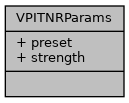Performs temporal noise reduction in a sequence of images. More...
Data Structures | |
| struct | VPITNRParams |
| Structure that defines the parameters for vpiSubmitTemporalNoiseReduction. More... | |
Enumerations | |
| enum | VPITNRPreset |
| Defines scene presets for temporal noise reduction. More... | |
| enum | VPITNRVersion |
| Defines the version of the Temporal Noise Reduction algorithm to be used. More... | |
Functions | |
| VPIStatus | vpiCreateTemporalNoiseReduction (uint64_t backends, int32_t width, int32_t height, VPIImageFormat imgFormat, VPITNRVersion version, VPIPayload *payload) |
| Creates a payload for Temporal Noise Reduction algorithm. More... | |
| VPIStatus | vpiInitTemporalNoiseReductionParams (VPITNRParams *params) |
| Initializes vpiSubmitTemporalNoiseReduction with default values. More... | |
| VPIStatus | vpiSubmitTemporalNoiseReduction (VPIStream stream, uint64_t backend, VPIPayload payload, VPIImage prevFrame, VPIImage curFrame, VPIImage outFrame, const VPITNRParams *params) |
| Submits a Temporal Noise Reduction operation to the stream. More... | |
Detailed Description
Performs temporal noise reduction in a sequence of images.
Refer to Temporal Noise Reduction for more details and usage examples.
Data Structure Documentation
◆ VPITNRParams
| struct VPITNRParams |
Structure that defines the parameters for vpiSubmitTemporalNoiseReduction.
Definition at line 166 of file TemporalNoiseReduction.h.
 Collaboration diagram for VPITNRParams:
Collaboration diagram for VPITNRParams:| Data Fields | ||
|---|---|---|
| VPITNRPreset | preset | Scene preset to be used. |
| float | strength |
Noise reduction strength.
|
Enumeration Type Documentation
◆ VPITNRPreset
| enum VPITNRPreset |
#include <vpi/algo/TemporalNoiseReduction.h>
Defines scene presets for temporal noise reduction.
These presets are used by Temporal Noise Reduction to define its internal parameters suitable for noise reduction of scenes captured with given characteristics.
Definition at line 83 of file TemporalNoiseReduction.h.
◆ VPITNRVersion
| enum VPITNRVersion |
#include <vpi/algo/TemporalNoiseReduction.h>
Defines the version of the Temporal Noise Reduction algorithm to be used.
Higher version numbers usually achieve better quality.
Definition at line 97 of file TemporalNoiseReduction.h.
Function Documentation
◆ vpiCreateTemporalNoiseReduction()
| VPIStatus vpiCreateTemporalNoiseReduction | ( | uint64_t | backends, |
| int32_t | width, | ||
| int32_t | height, | ||
| VPIImageFormat | imgFormat, | ||
| VPITNRVersion | version, | ||
| VPIPayload * | payload | ||
| ) |
#include <vpi/algo/TemporalNoiseReduction.h>
Creates a payload for Temporal Noise Reduction algorithm.
This function allocates all resources needed by the algorithm and ties the returned payload to the given backend.
- Parameters
-
[in] backends VPI backends that are eligible to execute the algorithm. - Valid values:
- Backend must be enabled in current context.
[in] width,height Dimensions of frames to be processed. - Must be positive.
[in] imgFormat Format of the images to be processed. - Supported formats:
Formats VIC CUDA VPI_IMAGE_FORMAT_NV12_ER * * VPI_IMAGE_FORMAT_NV12_ER_BL * * VPI_IMAGE_FORMAT_YUYV_ER * VPI_IMAGE_FORMAT_YUYV_ER_BL * VPI_IMAGE_FORMAT_UYVY_ER * VPI_IMAGE_FORMAT_UYVY_ER_BL *
[in] version Version of the algorithm to be used. [out] payload Pointer to the payload variable that receives the created handle.
- Return values
-
VPI_IMAGE_FORMAT_INVALID imgFormatis not supported.VPI_ERROR_INVALID_ARGUMENT payloadis NULL.VPI_ERROR_INVALID_ARGUMENT widthorheightoutside valid range.VPI_ERROR_INVALID_ARGUMENT Invalid TNR version.VPI_ERROR_INVALID_ARGUMENT backendsrefers to an invalid backend.VPI_ERROR_INVALID_OPERATION No VIC support is available. VPI_ERROR_INVALID_OPERATION Backend isn't enabled in current context. VPI_ERROR_NOT_IMPLEMENTED Temporal Noise Reduction algorithm version is not supported by given backend. VPI_ERROR_NOT_IMPLEMENTED VIC Hardware with TNRv3 support is not available. VPI_ERROR_INVALID_CONTEXT Current context is destroyed. VPI_ERROR_OUT_OF_MEMORY Cannot allocate required resources. VPI_SUCCESS Operation executed successfully.
◆ vpiInitTemporalNoiseReductionParams()
| VPIStatus vpiInitTemporalNoiseReductionParams | ( | VPITNRParams * | params | ) |
#include <vpi/algo/TemporalNoiseReduction.h>
Initializes vpiSubmitTemporalNoiseReduction with default values.
Defaults:
- preset: VPI_TNR_PRESET_DEFAULT
- strength: 0.5
- Parameters
-
[in] params Structure to be filled with default values.
- Return values
-
VPI_ERROR_INVALID_ARGUMENT paramsis NULL.VPI_SUCCESS Operation executed successfully.
◆ vpiSubmitTemporalNoiseReduction()
| VPIStatus vpiSubmitTemporalNoiseReduction | ( | VPIStream | stream, |
| uint64_t | backend, | ||
| VPIPayload | payload, | ||
| VPIImage | prevFrame, | ||
| VPIImage | curFrame, | ||
| VPIImage | outFrame, | ||
| const VPITNRParams * | params | ||
| ) |
#include <vpi/algo/TemporalNoiseReduction.h>
Submits a Temporal Noise Reduction operation to the stream.
- Parameters
-
[in] stream The stream where the operation will be queued in. - Must not be NULL.
- Stream must have enabled the backends that will execute the algorithm.
[in] backend Backend that will execute the algorithm. - Must be the backend specified during payload creation or 0 as a shorthand to use this backend.
[in] payload Payload to be submitted along the other parameters. [in] prevFrame Result of the previous iteration. If the frame passed isn't the result image of the previous iteration, TNR will consider it to be NULL, i.e, the internal state will be reset and curFramewill be considered to be the first frame of a new sequence to be denoised.- When processing the first frame of a video sequence, this must be NULL.
- Must have same format and dimensions as the one specified during payload creation.
- Input must have enabled the backends that will execute the algorithm.
[in] curFrame Current (noisy) frame to be processed. - Must not be NULL.
- Must have same format and dimensions as the one specified during payload creation.
- Input must have enabled the backends that will execute the algorithm.
[out] outFrame Output frame, where de-noised image will be written to. - Must not be NULL.
- Must have same format and dimensions as the one specified during payload creation.
- Input must have enabled the backends that will execute the algorithm.
[in] params Control parameters for temporal noise reduction If NULL, it'll use the defaults given by vpiInitTemporalNoiseReductionParams.
- Return values
-
VPI_ERROR_INVALID_ARGUMENT streamis NULL.VPI_ERROR_INVALID_ARGUMENT curFrameoroutFrameare NULL.VPI_ERROR_INVALID_ARGUMENT payloadis not generated using vpiCreateTemporalNoiseReduction family of functions.VPI_ERROR_INVALID_ARGUMENT prevFrame,curFrameandoutFramemust have the same format and size configured duringpayloadcreation.VPI_ERROR_INVALID_ARGUMENT Strength in paramsoutside valid range.VPI_ERROR_INVALID_PAYLOAD_TYPE payloadis invalid.VPI_ERROR_INVALID_OPERATION The needed backends aren't enabled in stream,prevFrame,curFrameoroutFrame.VPI_SUCCESS Operation executed successfully.
